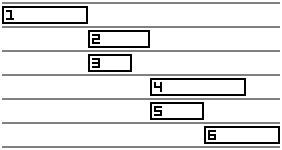To me, the current API, with the current names, is relatively intuitive. The factory methods like parallel() change the following tween animation or affect the following sequence. That's at least how I expect factory methods to work.
If people struggle to understand or use it overall, then why not change the way it works. But that should be the starting condition. I personally haven't had trouble trying the new system for concrete tween animations.
If others struggle with the new system and feel the proposed one's more intuitive, I'd just like to recommend naming changes. To me, "parallel()" doesn't suggest I'm opening a group that I have to close. I prefer explicit names like: create_parallel_group() or make_parallel_group() instead of parallel() and close_group() instead of end(). That way, the intended usage is clearer.
I'd also personally rather use a data structure to represent this kind of group/layer structure rather than factory methods. It would better fit the proposed uses (a bit like how flutter and other web frameworks let you define structures or animations). Although nowhere else in GDScript you have something like this so I don't think it fits well into Godot's API.
Anyway, the most important aspect for me is to first see if more people have had issues working with the current API in practice.
Describe the project you are working on
Not relevant.
Describe the problem or limitation you are having in your project
The current version of the Tween system in 4.0 is surely an improvement over the 3.x one. But in my opinion it has a few pitfalls that could be fixed in time with the final release and would bring improved usability for intermediate to advanced users, still keeping it simple for basic stuff.
Here's an example for a tween configuration:
The current implementation provides several approaches to get this result.
Await approach:
Callable approach:
Mix:
There is a recurring problem with each approach: declaring parallel tweeners is often confusing, error prone or requires the use of several language features that could be avoided.
Describe the feature / enhancement and how it helps to overcome the problem or limitation
A more flexible way of declaring complex tweens is preferable in my opinion.
Tween objects would be containers of Tweeners. Tweeners can be simple PropertyTweeners, MethodTweeners, etc. or group of tweeners: SequenceTweener, ParallelTweener.
Tweens and groups of tweeners can create and append other tweeners to themselves. When they do, the new tweener is returned, and can be used to further create and append nested tweeners.
If a non-group tweener tries to generate a new tweener, the newly created tweener is requested to be added to the parent tweener until a tweener group is found.
Describe how your proposal will work, with code, pseudo-code, mock-ups, and/or diagrams
This is the approach this proposal proposes, here illustrated in length:
The one above is the lengthy and verbose approach that provides the highest flexibility. E.g. groups of tweeners could be passed around and configured independently from the other steps of the tween.
For simpler or more strainghforward tween configurations, here's what the proposed API would allow:
This version is much more readable and doesn't involve using other GDScript features in a creative way.
If this enhancement will not be used often, can it be worked around with a few lines of script?
Maybe a GDScript wrapper around the current implementation is possible but it's not very convenient.
Is there a reason why this should be core and not an add-on in the asset library?
Tweens should provide flexibility out of the box, it would be a shame to have almost all the components needed to bring their usability to the next level, just to lack a few of them.